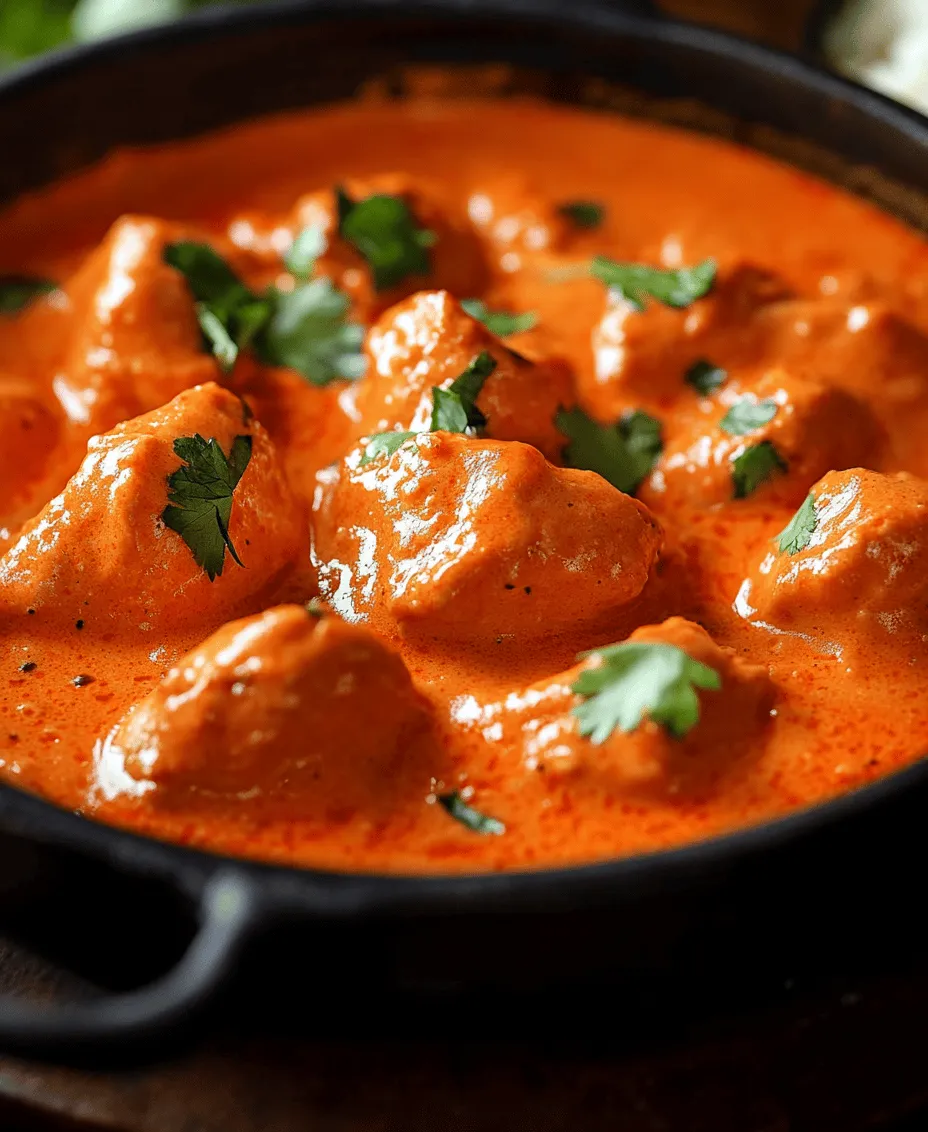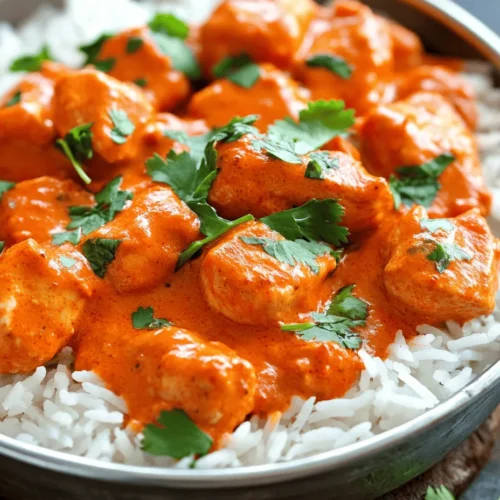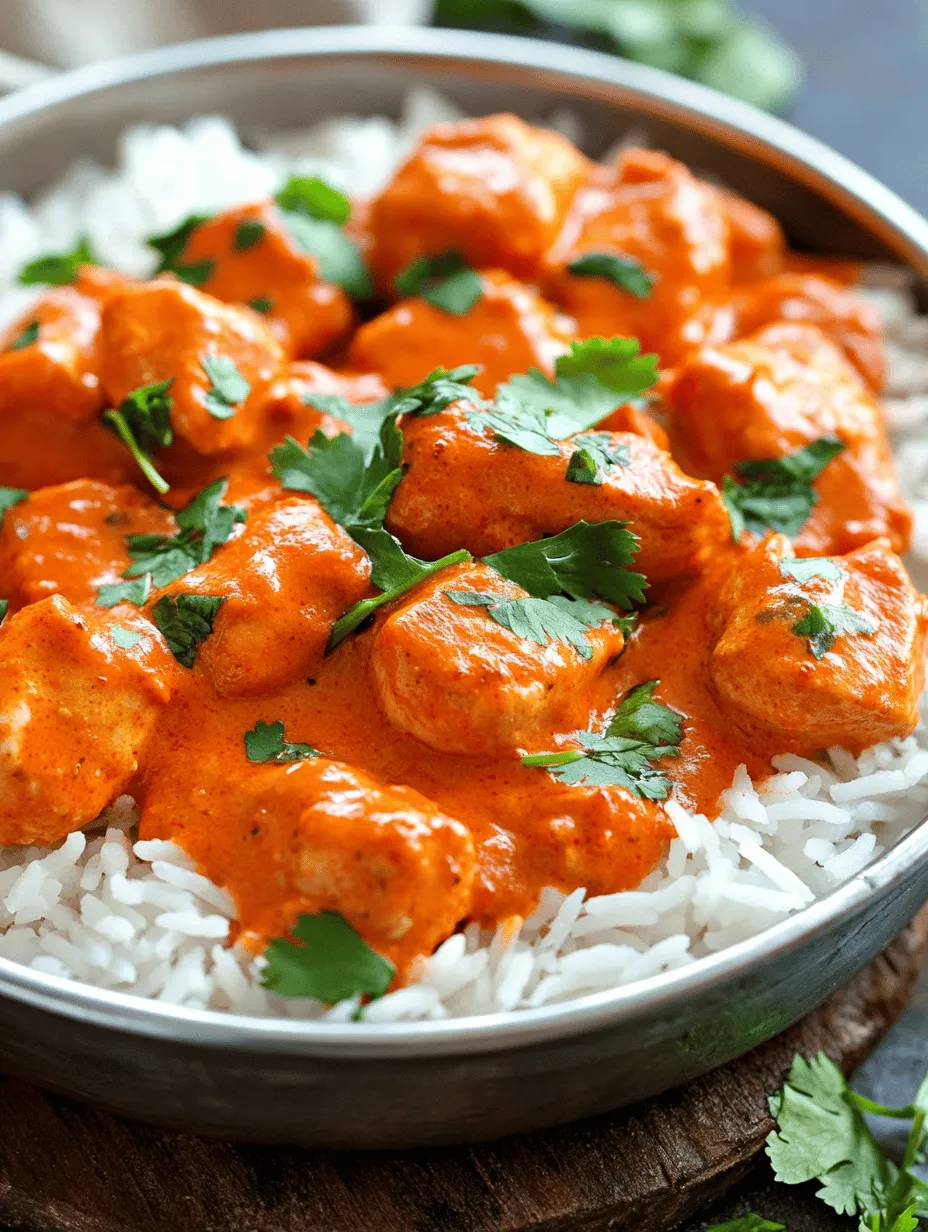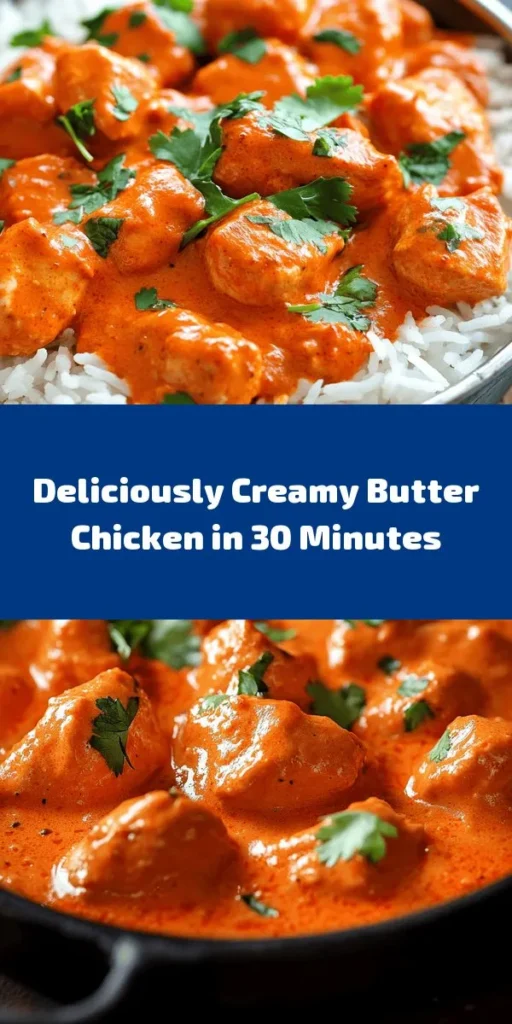Introduction
Butter chicken, known as Murgh Makhani in its native tongue, is a quintessential dish that embodies the rich culinary heritage of India. Renowned for its creamy texture and robust flavors, this dish has become a staple in Indian restaurants around the globe and a beloved favorite among food enthusiasts. The charm of butter chicken lies not only in its taste but also in its comforting nature, making it a perfect choice for gatherings, family dinners, or a cozy night in.
The allure of butter chicken is its simplicity in preparation coupled with profoundly rich flavors. It invites both novice cooks and seasoned chefs to embark on a culinary adventure without requiring extensive expertise or hard-to-find ingredients. As Indian cuisine continues to gain popularity across continents, butter chicken stands out as a testament to the delicious and diverse offerings of this vibrant culture.
Understanding Butter Chicken
The History of Butter Chicken (Murgh Makhani)
Butter chicken has a storied history that traces back to the 1950s in the bustling city of Delhi. Legend has it that the dish was created by the chefs at the Moti Mahal restaurant, who sought to minimize food waste by repurposing leftover tandoori chicken. They devised a luscious tomato-based sauce enriched with butter and cream, resulting in a dish that quickly gained fame and adoration.
The original recipe reflects the traditional Punjabi cooking style, characterized by its use of spices and slow-cooked methods that enhance flavors. Over the years, butter chicken has transcended its humble beginnings to become a symbol of Indian cuisine, celebrated for its ability to bring people together over a shared love of food.
Its Origins in Punjab and Evolution Over the Years
Rooted in the fertile region of Punjab, butter chicken is a dish that showcases the agricultural abundance of this area. The use of dairy products, such as butter and cream, is a hallmark of Punjabi cuisine, and its influence is evident in the richness of this dish. As it traveled beyond the borders of India, butter chicken adapted to various palates, leading to regional variations and interpretations.
Today, butter chicken is not only a staple in Indian households but has also made its way into international culinary scenes, with chefs experimenting with different ingredients and techniques, thus keeping the essence of the dish alive while making it accessible to a broader audience.
The Dish’s Place in Modern Culinary Trends
In recent years, butter chicken has garnered attention not just for its delightful taste but also for its versatility. As health-conscious eating habits have become more prevalent, many home cooks are reimagining traditional recipes, incorporating lighter ingredients without compromising on flavor. From vegan adaptations using cashew cream to gluten-free options, butter chicken is proving that it can evolve while still remaining true to its roots.
This dish’s increasing popularity is also fueled by social media, where food photography and sharing have brought the vibrant colors and textures of butter chicken to the forefront. As more people discover and experiment with Indian cuisine, butter chicken remains a gateway dish, inviting culinary exploration and appreciation for the rich tapestry of flavors that define Indian cooking.
Ingredients Breakdown
The success of butter chicken lies in its carefully selected ingredients, each playing a pivotal role in creating the dish’s signature taste and texture. Understanding these components will not only enhance your cooking experience but also ensure that your butter chicken turns out delicious every time.
Overview of Main Ingredients and Their Roles in the Dish
1. Boneless Chicken Thighs or Breasts: The choice between chicken thighs and breasts can significantly affect the dish’s final outcome. Chicken thighs tend to be juicier and more flavorful due to their higher fat content, making them ideal for this recipe. On the other hand, chicken breasts are leaner and can be used for a lighter version of the dish. However, for the most authentic butter chicken experience, boneless chicken thighs are recommended.
2. Ghee or Unsalted Butter: Ghee, a type of clarified butter commonly used in Indian cooking, enhances the dish’s richness and provides a distinct flavor. Unsalted butter can also be used as a substitute, but ghee elevates the overall taste profile with its nutty aroma and smooth texture.
3. Fresh Aromatics (Onion, Garlic, and Ginger): These ingredients form the flavor foundation of butter chicken. Onions, when sautéed to a golden brown, impart sweetness and depth. Fresh garlic and ginger add warmth and a hint of spice that elevates the dish.
4. Spices (Garam Masala, Cumin, Coriander, Turmeric, and Cayenne Pepper): The spice blend is crucial in defining butter chicken’s unique flavor. Garam masala, a blend of ground spices, lends warmth and complexity. Cumin and coriander provide earthiness, while turmeric imparts a golden hue and subtle bitterness. Cayenne pepper adds heat, which can be adjusted to personal preference.
5. Tomatoes and Cream: The sauce’s heart is formed by the combination of ripe tomatoes and heavy cream. Tomatoes bring acidity and sweetness, balancing the richness of the butter and cream. Meanwhile, cream contributes to the dish’s luxurious mouthfeel, creating a velvety sauce that clings to the chicken.
6. Fresh Cilantro for Garnishing: A finishing touch of freshly chopped cilantro not only adds a pop of color but also enhances the dish’s freshness, balancing the richness of the butter chicken.
Importance of Using Boneless Chicken Thighs vs. Breasts
As mentioned, the choice of chicken cuts can make a noticeable difference in the final dish. Boneless chicken thighs are favored for their tenderness and ability to absorb the marinade and sauce flavors, resulting in juicy bites. Chicken breasts, while a healthier option, can dry out if overcooked. If you prefer using breasts, be mindful of cooking times and consider marinating them longer to infuse more flavor and moisture.
The Role of Ghee or Unsalted Butter in Flavor Development
Ghee or unsalted butter serves as the cooking fat for this dish, critical for developing flavors and providing richness. Ghee has a higher smoke point than regular butter, allowing it to be used for sautéing the aromatics without burning. The nutty flavor of ghee complements the spices and enhances the overall taste of the butter chicken.
Fresh Aromatics: Onion, Garlic, and Ginger – The Flavor Foundation
The aromatic trio of onion, garlic, and ginger is essential in building the flavor base for butter chicken. Sautéing onions until they are golden brown transforms their sharpness into sweetness, creating a rich foundation. Adding minced garlic and ginger at this stage releases their essential oils, further deepening the flavor profile.
Exploration of Spices: Garam Masala, Cumin, Coriander, Turmeric, and Cayenne Pepper
The use of spices is what makes butter chicken a standout dish. Garam masala, a blend of spices specific to Indian cuisine, is typically added towards the end of cooking to preserve its bold flavor. Cumin and coriander are often used in the initial stages to create a complex base, while turmeric is added for color and a mild earthy flavor. Adjusting the amount of cayenne pepper allows you to customize the heat level of the dish, making it suitable for varying palates.
The Significance of Tomatoes and Cream in Creating the Sauce’s Richness
Tomatoes are integral to the sauce, providing acidity and sweetness that balance the richness of the butter and cream. Using ripe, fresh tomatoes or high-quality canned tomatoes can make a significant difference in flavor. The addition of cream transforms the sauce into a luxurious, velvety coating for the chicken, ensuring every bite is indulgent.
Suggestions for Garnishing: Fresh Cilantro
A sprinkle of fresh cilantro adds a burst of color and brightness to the dish, countering the heaviness of the sauce. Its vibrant flavor complements the spices and enhances the overall presentation, making butter chicken not only delicious but also visually appealing.
Step-by-Step Cooking Instructions
Now that we’ve covered the essential ingredients, it’s time to dive into the step-by-step cooking instructions that will guide you in creating this flavorful butter chicken. These instructions will ensure that you achieve the perfect balance of flavors and textures that make this dish so beloved.
Sautéing the Base: Achieving the Perfect Onion Texture
1. Preparation: Begin by gathering all your ingredients and preparing them for cooking. Cut the boneless chicken thighs into bite-sized pieces and set them aside. Finely chop two medium onions, mince four cloves of garlic, and grate a one-inch piece of fresh ginger.
2. Heat the Ghee: In a large, heavy-bottomed pan or Dutch oven, heat 2 tablespoons of ghee over medium heat until melted. If using unsalted butter, allow it to melt completely, ensuring it doesn’t brown.
3. Sauté the Onions: Add the chopped onions to the pan, stirring frequently to prevent sticking. Cook the onions for about 8-10 minutes or until they turn golden brown. Achieving the right onion texture is crucial, as it forms the flavor base for the dish. An undercooked onion will have a sharp taste, while overcooked onions can become bitter.
4. Incorporate Garlic and Ginger: Once the onions are perfectly caramelized, add the minced garlic and grated ginger to the pan. Sauté for an additional 1-2 minutes until fragrant, making sure not to burn the garlic, which can impart a bitter flavor to the dish.
5. Add the Spices: Now, it’s time to introduce the spices. Add 1 teaspoon of cumin seeds, 1 teaspoon of coriander powder, 1 teaspoon of turmeric powder, and 1 teaspoon of garam masala to the pan. Stir the spices into the onion mixture, allowing them to toast for about a minute. This step releases their essential oils and enhances their flavors, creating a fragrant base for your butter chicken.
6. Incorporate the Chicken: Next, add the chicken pieces to the pan, stirring to coat them in the aromatic mixture. Cook the chicken for about 5-7 minutes, allowing it to sear slightly and take on a golden color.
At this point, you have laid the groundwork for your savory butter chicken bliss. The next steps will involve adding the tomatoes and cream to create the signature sauce that complements the chicken.
Stay tuned for the continuation where we delve into the creation of the sauce, the finishing touches, and tips for serving this delectable dish!

The Importance of Cooking Garlic and Ginger Properly to Enhance Flavors
When it comes to creating an unforgettable butter chicken, the proper preparation and cooking of garlic and ginger are crucial. These two aromatic ingredients serve as the foundation of flavor in many Indian dishes, including butter chicken. For optimal results, always use fresh garlic and ginger, as their potency significantly contributes to the dish’s overall taste.
Start by finely mincing or grating both the garlic and ginger. This increases their surface area, allowing the essential oils to release more flavor during cooking. Heat a generous amount of oil or ghee in a large pan over medium heat. Once hot, add the minced garlic and ginger, sautéing them until they become fragrant and golden brown, typically for about 1 to 2 minutes. Be cautious not to burn them, as this can lead to a bitter taste that will overshadow the delicate flavors of the dish.
Techniques for Browning Chicken to Lock in Moisture and Flavor
Browning the chicken is a critical step in ensuring that your butter chicken is both flavorful and juicy. Begin by cutting the chicken into bite-sized pieces, which allows for even cooking. Before adding the chicken to your pan, pat it dry with paper towels to remove excess moisture, which helps achieve a beautiful golden-brown crust.
Heat oil or ghee in a heavy-bottomed skillet over medium-high heat. Once the oil is shimmering, carefully add the chicken pieces in a single layer, ensuring not to overcrowd the pan. This will help the chicken brown rather than steam. Allow the chicken to sear undisturbed for about 4 to 5 minutes before flipping it to the other side. The goal here is to develop a rich, caramelized exterior, which adds depth to the overall flavor profile of your butter chicken.
The Art of Seasoning: How to Balance Spices for Optimal Taste
Seasoning is the heart of Indian cooking, and butter chicken is no exception. The key to balancing spices lies in understanding their individual flavors and how they interact with one another. Start with a base of classic spices such as cumin, coriander, turmeric, and garam masala. Each spice contributes its unique characteristics to the dish and must be measured carefully.
As you season your chicken, add spices gradually, tasting as you go. This method allows you to adjust the flavors to your preference. When adding spices, it’s best to toast them in the pan for a minute or two before incorporating any liquids. This technique releases their essential oils and enhances their flavors, ensuring a more robust final dish.
Creating the Sauce: Tips for Simmering and Achieving the Right Consistency
The sauce is what truly makes butter chicken shine. After browning the chicken and cooking the garlic and ginger, it’s time to create your sauce. Begin by adding crushed tomatoes to the pan, followed by a splash of water or stock to help deglaze and lift the flavorful bits stuck to the bottom.
Let the mixture simmer gently for about 20 minutes, allowing the flavors to meld and develop. Keep an eye on the consistency; if it becomes too thick, add more liquid until you achieve a creamy, sauce-like texture. The goal is to create a rich sauce that clings to the chicken without being too watery or overly thick.
The Finishing Touch with Cream: When and How to Add It for the Best Results
Cream is the final touch that elevates butter chicken to its creamy, indulgent state. Once your sauce has simmered and developed a robust flavor, it’s time to add the cream. Remove the pan from heat before pouring in the cream to prevent it from curdling. Stir gently to incorporate the cream, allowing it to meld seamlessly with the sauce.
For an extra layer of flavor, consider adding a pinch of sugar to balance the acidity of the tomatoes and enhance the overall taste. Return the pan to low heat for a few minutes to warm the dish through, ensuring that the flavors have time to marry beautifully.
Serving Suggestions
Ideal Pairings: Basmati Rice vs. Naan Bread
When it comes to serving butter chicken, the classic accompaniments are basmati rice or naan bread. Basmati rice is an aromatic long-grain rice that soaks up the sauce beautifully, providing a lovely contrast in texture. Alternatively, naan bread, with its soft, pillowy texture, is perfect for scooping up the creamy sauce. Both options bring their unique qualities to the table, making it a matter of personal preference.
Suggestions for Side Dishes that Complement Butter Chicken
To create a well-rounded meal, consider pairing your butter chicken with side dishes that complement its rich flavors. A simple cucumber raita, made from yogurt and fresh herbs, can provide a refreshing contrast to the spiciness of the dish. Additionally, serving a mixed green salad tossed with a tangy lemon vinaigrette can add brightness and balance.
For those looking to add a bit of crunch, crispy vegetable pakoras or samosas can be delightful appetizers that set the stage for the main event. These fried snacks add texture and flavor diversity, enhancing the overall dining experience.
Creative Serving Ideas for Entertaining Guests
If you’re entertaining guests, consider serving butter chicken family-style. Present the dish in a large serving bowl, accompanied by warm naan and basmati rice in separate dishes. This encourages sharing and creates a convivial atmosphere. Garnishing the butter chicken with freshly chopped cilantro and a sprinkle of crushed red pepper flakes can add visual appeal and invite your guests to dive into the feast.
Nutritional Information
Breakdown of Calories, Fats, Proteins, and Carbohydrates Per Serving
When enjoying butter chicken, it’s essential to be mindful of the nutritional content. A standard serving of butter chicken (approximately 1 cup) contains roughly 400-500 calories, depending on the amount of cream used. The dish typically has 20-25 grams of fat, primarily from the cream and oil, while providing about 30-35 grams of protein from the chicken. Carbohydrate content can vary based on whether you serve it with rice or naan, but it generally ranges from 30-50 grams.
Discussion on the Health Benefits of Key Ingredients
Butter chicken is not only indulgent but also offers health benefits from its key ingredients. Chicken is an excellent source of lean protein, which is essential for muscle repair and overall health. The spices used in the dish, such as turmeric and cumin, are renowned for their anti-inflammatory properties, contributing to various health benefits.
Consideration for Dietary Restrictions and Modifications
For those with dietary restrictions, there are several modifications you can make. To create a dairy-free version, substitute the cream with coconut milk or cashew cream, which will still provide that rich texture while accommodating lactose intolerance. If you’re looking to reduce calories, consider using skinless chicken breasts and reducing the amount of cream or oil.
Storing and Reheating Butter Chicken
Best Practices for Storing Leftovers
If you find yourself with leftovers, butter chicken can be stored in an airtight container in the refrigerator for up to three days. To maintain the flavor and quality, allow the dish to cool completely before refrigerating.
How to Properly Reheat Butter Chicken While Preserving Its Flavor and Texture
When it comes to reheating, the stovetop is your best option. Gently warm the butter chicken in a skillet over low heat, adding a splash of water or additional cream to maintain moisture. Stir occasionally to ensure even heating. Avoid using the microwave, as it can lead to uneven heating and a change in texture.
Freezing Tips for Long-Term Storage
For those who wish to store butter chicken for a more extended period, freezing is an excellent option. Allow the dish to cool completely and then transfer it to a freezer-safe container. It can be frozen for up to three months. To reheat after freezing, transfer the dish to the refrigerator to thaw overnight before reheating on the stovetop.
Conclusion
Butter chicken is a charming dish that brings warmth and satisfaction to the dining table. The process of preparing this beloved recipe allows you to explore the rich and diverse flavors of Indian cuisine while providing a delightful experience for you and your loved ones.
We encourage you to dive into this accessible recipe and make it your own, experimenting with spices and ingredients to suit your taste. The joy of cooking and sharing food is at the heart of this culinary journey. Gather your family and friends, and enjoy the blissful flavors of butter chicken together, celebrating the magic of home-cooked meals and the connections they foster.



